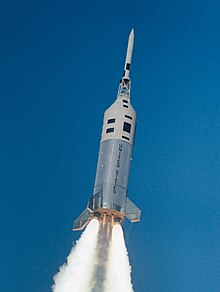The Algol family of solid-fuel rocket stages and boosters is built by Aerojet (now Aerojet Rocketdyne) and used on a variety of launch vehicles. It was developed by Aerojet from the earlier Jupiter Senior and the Navy Polaris programs.[1][2] Upgrades to the Algol motor occurred from 1960 until the retirement of the Scout launch vehicle in 1994.
The Algol family use solid propellant fuel with a loaded mass of 10,705 kg, and produces 470.93 kN of thrust. The vehicle also has a Specific Impulse of 236 seconds in a vacuum environment. Variations Algol I, I-D, II, II-A, II-BA popular rating was 40KS-115,000 (52,000 kgf for 40 seconds), also known as Senior.
They were initially developed as the first-stage of propulsion for the Scout rocket, with the design being based on the UGM-27 Polaris, a submarine-launched ballistic missile developed for the United States Navy at the Jet Propulsion Laboratory.[3][4]
Algol 1 (XM-68)
- Algol 1 (XM-68)
This rocket design started as the Polaris test motor, 31 feet in length with a 40 inches (1.0 m) diameter steel case, and 86,000 lb. of thrust. The eventual UGM-27 Polaris A-1 was larger, 28.5 feet (8.7 m) in length and 54 inches (1.4 m) in diameter.[5]
The Algol 1 was first used for a successful suborbital launch of a Scout X-1 rocket on September 2, 1960.[6] The rocket started as a UGM-27 Polaris test motor with a 40-inch diameter, the largest solid motor ever tested at the time. It had a nominal performance rating of 40 seconds duration and 45,000 kgf thrust. It was 19.42 feet (5.92 m) long, 2.6 feet (0.79 m) in diameter.[7] Later versions for Scout D scaled to 1.14 m (45 in) in diameter.
- Algol 1-A
Used on the Scout X (Cub Scout) test flight flown April 18, 1960. served as prototype vehicle for eventual Scout rocket.
- Algol 1-B
Used on Scout X-1, RM-89 Blue Scout I, and RM-90 Blue Scout II.
- Algol 1-C
Used on the Scout X-1A. After this single flight, the Scout X-2 with Algol 1-D replaced this prototype.
- Algol 1-D
Used with Scout X-2, Scout X-2M and Little Joe II. Solid rocket stage. 440.00 kN (98,916 lbf) thrust. Mass 10,700 kg (23,600 lb). It was first used on the Scout X-2 on March 29, 1962. It continued to be used on Scout X-2 and Scout X-2M launches (4) until 1963.

Algol 1-D was first used on the Little Joe II Qualification Test Vehicle in 1963.
May 13, 1964 – Algol Boosts Little Joe II A-001 flight. An Aerojet-built Algol 1D heavy-duty rocket motor performed successfully for the 36th consecutive time on May 13, 1964, as it carried a NASA Little Joe II spacecraft on the Apollo program A-001 test flight. Averaging 96,650 pounds thrust, the Algol 1D was the largest solid rocket motor flying in non-military space programs. Test hardware on May's successful Apollo test flight included: an unmanned instrumented command module, service module, launch escape system and the Little Joe II launch system.
Algol engine used on Little Joe II Thrust: 465 kN each Length: 9.1 m Diameter: 1 m Weight full: 10,180 kg Weight empty: 1,900 kg Fuel: solid Burn time: 40 s
Status: Retired 1966. Gross mass: 10,700 kg (23,600 lb). Unfuelled mass: 1,200 kg (2,600 lb). Height: 9.40 m (30.8 ft). Diameter: 1.02 m (3.3 ft). Thrust: 440.00 kN (98,910 lbf). Burn time: 44 s. Number: 20.
Algol II

The Algol 2 (Algol II) series was first flown in 1962. It was used a first stage on Scout A, Scout B, Scout X-3, Scout X-4; It was proposed as a strap-on motor for the Titan 3BAS2 variant (cancelled). It was also proposed for the Athena RTX program in 1969, losing to Thiokol.<GAO> B-165488, JAN. 17, 1969. Thrust (sl): 513.300 kN (115,394 lbf; 52,347 kgf).
The 3BAS2 configuration of Titan 3B rocket proposed by Martin in the mid-1960s would have been used for deep space missions with a Centaur upper stage, Algol strap-on for liftoff thrust augmentation. It was never flown.
CSD solid rocket engine. 564.2 kN. Isp=255s. Gross mass: 11,600 kg (25,600 lb). Unfuelled mass: 1,650 kg (3,640 lb). Height: 9.09 m (29.8 ft). Diameter: 1.01 m (3.3 ft). Thrust: 564.20 kN (126,837 lbf). Specific impulse: 255 s. Specific impulse sea level: 232 s.
The Algol II-A was introduced in 1963 using the Aerojet 40 KS motor. It first flew on Scout-X3 in 1963.
The Algol II-B was created after an Algol II-A flight failure, the nozzle was designed and designate the II-B model. It first flew on Scout-X4
The Algol II-C flew on Scout A1 and B1. Scout-A2, -B2, -C and -2 versions planned for Algol II-C were never used.
See also
References
- ^ Walter Edward Hammond (1999). Space Transportation: A Systems Approach to Analysis and Design. AIAA.
- ^ "Scout Launch Vehicle Program". NASA.
- ^ "NASA'S SCOUT LAUNCH VEHICLE". NASA GSFC. Archived from the original on 2008-05-10.
- ^ "SERGEANT". Redstone Arsenal. Archived from the original on 2008-06-12.
- ^ "Polaris A1". Federation of American Scientists. May 30, 1997. Retrieved April 1, 2023.
- ^ "TSE – Scout". The Satellite Encyclopedia.
- ^ "Algol-1". astronautix.com. Retrieved April 1, 2023.




Recent Comments